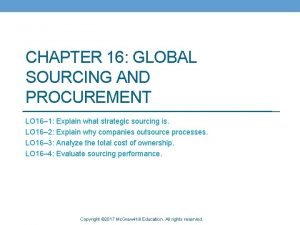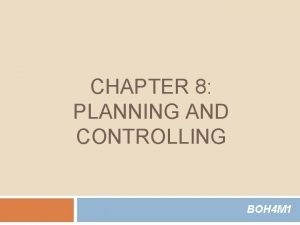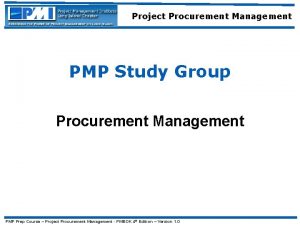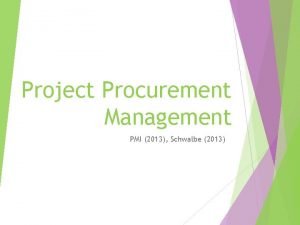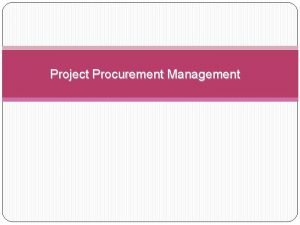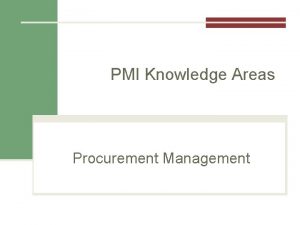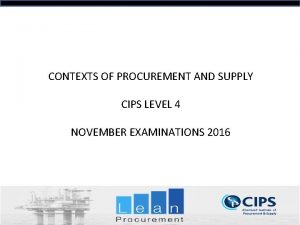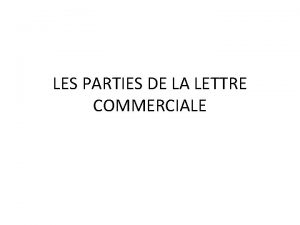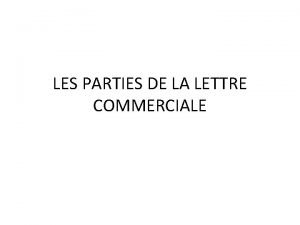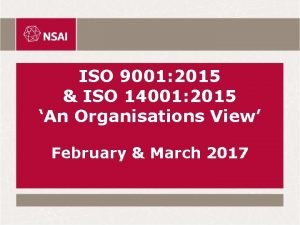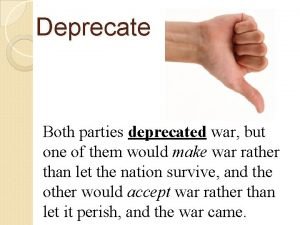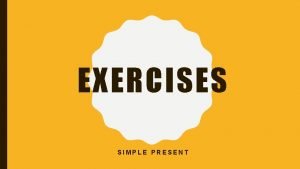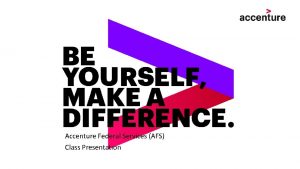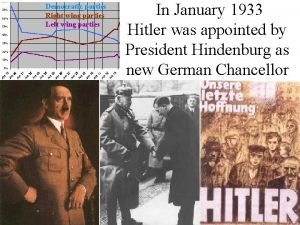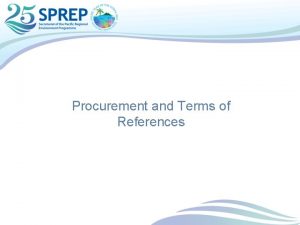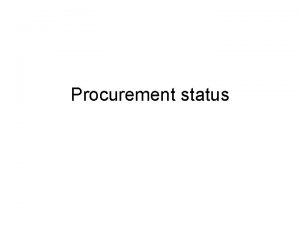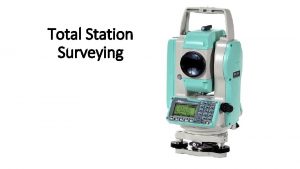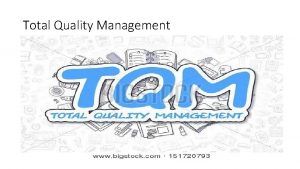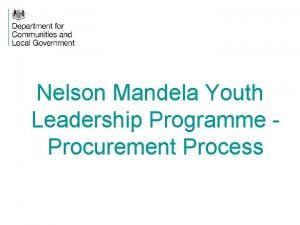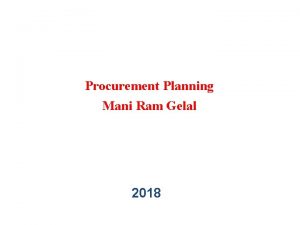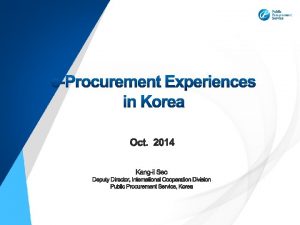Parties Involved in the Total Procurement Process Accenture








































- Slides: 40

Parties Involved in the Total Procurement Process Accenture research and insights into procurement performance mastery October 2008 Copyright © 2007 Accenture All Rights Reserved. Accenture, its logo, and High Performance Delivered are trademarks of Accenture.

Executive Summary Accenture looked practically at the profiles of 225 respondents as they relate to four procurement processes (strategy, sourcing and category management, requisition to pay, and supplier relationship management) and three key enablers (workforce, organization and technology). We found: l l Procurement masters excel across the board Procurement mastery is a clear predictor of high performance through procurement l Procurement masters achieve higher savings l Procurement masters face fewer organizational challenges Procurement masters have a clear advantage over the competition: Fundamentally, they operate more efficiently and effectively than companies that do not excel in procurement. Copyright © 2007 Accenture All Rights Reserved.

Contents l Background and objectives l Research approach l Key findings l High performance through procurement Copyright © 2007 Accenture All Rights Reserved.

Background and objectives l l Ongoing series of cross-industry studies in supply chain management We created and quantified a new term—“procurement mastery”—and explained its relationship to high performance (the traits exhibited by the roughly 10 percent of companies that consistently outperform their peers) Procurement has dramatically evolved into a strategic, proactive process Lower cost and higher productivity are the hallmarks of procurement mastery Copyright © 2007 Accenture All Rights Reserved.

Survey demographics Exceptionally high quality survey participants … by job function … by responsibility l l l … by experience … by 2005 revenues l Copyright © 2007 Accenture All Rights Reserved. 82% of respondents CPOs or Directors 74% are responsible for procurement on a companywide level 83% have more than 5 years’ experience in procurement, 59% more than 10 years 50% of companies are businesses with equal or more than 5 bn$ revenues (2005)

Survey demographics Broad and diverse industries and geographies …by industry … by geography l l *Services include i. e. health-, consulting-services, buying organizations Copyright © 2007 Accenture All Rights Reserved. Resources and Communications and High Tech represent the biggest industry segments US is the single biggest country in the survey

Contents l Background and objectives l Research approach l Key findings l High performance through procurement Copyright © 2007 Accenture All Rights Reserved.

Research approach l Research type: Quantitative l Format: Standardized questionnaire l l l l Methodology: Online interviews Target group: CPOs with corporate responsibility l Sample size: 600 responses, 225 indepth mastery analysis Qualifying criterion: international, big corporations Geographical scope: 19 countries from Europe, Americas, Asia-Pacific Industries: responses from 25 different industries such as Automotive, Banking, Chemicals, and so on Copyright © 2007 Accenture All Rights Reserved. l l Survey Approach and Design Create the high performance in procurement research model Formulate 160 statements describing the seven dimensions of procurement mastery framework Develop the procurement performance framework Commence online survey in Summer 2006

Research approach The survey is built on six dimensions of procurement mastery 1 Vision, mission, core values l Operating model Performance management l Category strategic planning l Procurement strategy l Sourcing and category management l l Requisition to pay l Transaction processing l Assisted buying l Supplier relationship management l 2 Strategic sourcing l Category policy setting 3 4 l 5 Workforce and organization l 6 Technology l Supplier performance mgt Contract management Having the right network of competent people Technology that delivers the right information Category management framework l Compliance monitoring Master data management l Fulfillment l l l Supplier development and integration Working in an organization that facilitates working together Systems cover all functions: strategy to operations Note: Internal stakeholder management is embedded in the categories 1 to 4 and was measured separately Copyright © 2007 Accenture All Rights Reserved.

Research approach 160 statements in total across every dimension 1 Procurement strategy 2 Sourcing & category management 3 Requisition to pay 4 Supplier relationship management 5 Workforce and organization Copyright © 2007 Accenture All Rights Reserved. 6 Technology

Research approach Masters are identified by achieving an overall score one standard deviation better than the average l l l The unweighted average of all procurement performance elements from all participants is calculated Master: The company‘s average mastery level is one standard deviation above the average Low performer: if the company‘s average mastery level is one standard deviation below the average Copyright © 2007 Accenture All Rights Reserved. Low performer Midrange performer Master 17% 67% 16% -1 Standard deviation +1

Research approach Performance is measured through an average score based on five factors over a three-year time frame 1 Total cost of ownership savings 2 Total controllable spend 3 Total cost of ownership savings / operating cost Percentage of spend controlled by procurement The ratio between total cost of ownership reduction and procurement operating cost 4 New product development Percentage of new product designs/introductions where procurement has a material role Formally managed suppliers Share of suppliers managed through a formal process* 5 Controlled, normalized average over 3 years * A formal process is the operational equivalent of what is a company’s documented procurement process, which describes how the company is purchasing goods and services Copyright © 2007 Accenture All Rights Reserved.

Contents l Background and objectives l Research approach l Key findings l High performance through procurement Copyright © 2007 Accenture All Rights Reserved.

Key findings Application of procurement mastery drives high performance results high Low performer Midrange performer Master l l Procurement performance Masters and low performers have been identified by analyzing 160 statements describing procurement processes in six dimensions according to Accenture’s procurement model Only those companies who are one standard deviation better than the average have been classified as master Average l low Procurement mastery Copyright © 2007 Accenture All Rights Reserved. high There are some companies with a high performance but a low or average best practice level (upper left box). Due to the wide and diverse sample, many different industries are part of our analysis and so there are very different companies within this category.

Key findings Masters consistently apply best practices across all dimensions Copyright © 2007 Accenture All Rights Reserved.

Key findings Masters are more efficient and have a 30% higher effectiveness year-on-year. This translates into 10 x higher productivity level Masters cost to procure are half as high but provide 30% higher savings vs. low performers Masters save 10 times as much as it costs them to operate their procurement organizations 10 x +30% 4 x -50% * On US$1 billion of controlled, normalized spend Copyright © 2007 Accenture All Rights Reserved. * On US$1 billion of controlled, normalized spend

Key findings In an environment demanding excessive cost reductions masters are challenged with organizational barriers and lack of talent Master * Out of 14 barrier the top 5 are listed Copyright © 2007 Accenture All Rights Reserved. Low performer

Contents l Background and objectives l Research approach l Key findings l High performance through procurement Copyright © 2007 Accenture All Rights Reserved.

High performance through procurement l Procurement strategy l Sourcing and category management l Requisition to pay l Supplier relationship management l Workforce and organization l Technology Copyright © 2007 Accenture All Rights Reserved.

Procurement strategy Masters systematically apply a strategic approach to purchasing, aligning it to the business needs and proactively managing relationships l l l Copyright © 2007 Accenture All Rights Reserved. Masters undertake strategic category planning (3– 5 years exploration) proactively for critical business categories i. e. looking at future business needs/identifying trends to plan supplier selection strategy/relationship to guarantee supply at the right cost. Masters have a clear mandate from top management and full accountability to achieve big business impact (innovation, cost reduction, etc. ) 80% of masters measure procurement performance using a balanced scorecard; a clear definition of value is shared throughout the company to drive purchasing decisions.

Procurement strategy A third of all masters source indirect goods through outsourcing or contracting out “Contract out” and “Outsourcing” of Indirect goods (Percentage of responses) l Procurement: make or buy options Copyright © 2007 Accenture All Rights Reserved. l 34% of masters already contract out or outsource the sourcing of indirect goods 66% source indirect goods through In -house or buy-In services.

Masters externalize three times more transaction Procurement management tasks strategy Masters externalize three times more transaction management tasks “Contract out” and “Outsourcing” of transaction management (Percentage of responses) 3 x more Average for all transaction management functions Copyright © 2007 Accenture All Rights Reserved. By transaction management functions

High performance through procurement l Procurement strategy l Sourcing and category management l Requisition to pay l Supplier relationship management l Workforce and organization l Technology Copyright © 2007 Accenture All Rights Reserved.

Masters leverage centralization and cross. Sourcing and category functional perspectives to provide best practice management sourcing & category management Masters leverage centralization and cross-functional perspectives to provide best practice sourcing & category management Best practice sourcing and category management l (Percentage of responses on a best practice level) l 100% of masters have implemented a centrally guided category management structure, which cuts across organizational entities. A quarter of low performers are also moving towards such a structure. 90% of masters have a best practices strategic sourcing process and structure in place that includes: - Cross-functional sourcing teams defining for a given category-project the optimal sourcing strategy, running the supplier selection and implementing the contracts. This is an end-to-end process without handovers. - The execution of the project is formally tracked against key milestones. - Cross-functional collaboration is formalized top-down through the structure of category boards. These boards typically hold senior people from different technical and user-departments on top of procurement organization and project leadership. Copyright © 2007 Accenture All Rights Reserved.

Sourcing and category management Masters have a systematic approach to global sourcing, use dedicated sourcing experts and have a clear mandate to drive change l l l Another key differentiating practice, that sets masters apart from low performers is related to how they leverage low-cost country or global sourcing. For 87% of masters low-cost country sourcing is one of the key levers for value creation, not through ad-hoc opportunistic projects with agents, but a well-orchestrated set of direct sourcing projects, based on total landed cost decisions. 80% of masters have a dedicated sourcing analyst pool to enable excellence in analytical support during the sourcing and category management process. A mere 5% of low performers have started to think to set-up a specialized analytics support. We see a trend of companies off shoring these analytical support activities to countries like India. When reviewing the survey participants feedback on how much control and impact they have on non-compliance, we see a correlation with how well they were able to tie procurement practices into the financial budgeting practices. 81% of masters versus 3% of low performers indicate that they have properly realized integration with financial processes and at the same time have the mandate to propose and drive corrective actions to reduce non-compliance. Copyright © 2007 Accenture All Rights Reserved.

High performance through procurement l Procurement strategy l Sourcing and category management l Requisition to pay l Supplier relationship management l Workforce and organization l Technology Copyright © 2007 Accenture All Rights Reserved.

Requisition to pay Masters invest in efficient and transparent approval chains, using assisted buying concepts Best practice in requisition to pay l (Percentage of responses on a best practice level) l l Copyright © 2007 Accenture All Rights Reserved. 83% of masters provide clear and documented buying channels to the end -user. Category specific processes are defined, transparent and consolidated through buying portals. Masters enjoy 67% catalogue buying and the approval chains are efficient and transparent at 89%. Masters focus and learn from assisted buying to improve their requisition to pay efficiency and effectiveness continuously and drive towards further reduction of “spot” buys. Three quarters of masters manage the process from requisition to payment fully integrated and strongly automated.

High performance through procurement l Procurement strategy l Sourcing and category management l Requisition to pay l Supplier relationship management l Workforce and organization l Technology Copyright © 2007 Accenture All Rights Reserved.

Supplier relationship management Masters combine a strategic approach to segmentation with an automated supplier performance assessment Best practice in supplier relationship management (Percentage of responses on a best practice level) l l Copyright © 2007 Accenture All Rights Reserved. Masters excel over low performers in that they apply a supply-base segmentation strategy, implementing differentiated approaches by supplier segments and tiers. Masters focus on key suppliers and establish with them long-term partnering agreements. Masters centrally log contracts and proactively manage contract information and compliance data. Tracking and reporting suppliers’ performances and assessment is an area of improvement for masters.

Supplier relationship management Masters formally manage three quarters of their supplybase, three times as much as low performers Share of formally managed suppliers l (Three year average in percentage) l Copyright © 2007 Accenture All Rights Reserved. When managing suppliers, masters have nearly 3 times more suppliers they manager through a formal process than less experienced companies. A formal process is the operational equivalent of what is a company’s documented procurement process, which describes how the company is purchasing goods and services

Supplier relationship management A rigor and systematic suppliers management A global industrial conglomerate in aerospace, food-manufacturing equipment and technical services has been working to master procurement processes such as strategic sourcing, contract management and compliance management. It now is focusing on developing and sustaining long-term relationships with key suppliers, and achieving mastery in the monitoring and management of supplier performance. Three stages comprise this effort. First is the establishment of a formal supplierdevelopment process and a consistent set of key performance indicators for measuring supplier performance. Forty-four key performance indicators were established across four main categories: quality, logistics, technology and cost. Each key performance indicator includes specific descriptions and measurements. The second phase emphasizes the deployment of these two capabilities. The third phase involves an information technology solution that automates the entire process. Key to these phases are “improvement action plans” that transform key performance indicator results into clearly defined business cases for the implementation of specific improvements. Copyright © 2007 Accenture All Rights Reserved.

High performance through procurement l Procurement strategy l Sourcing and category management l Requisition to pay l Supplier relationship management l Workforce and organization l Technology Copyright © 2007 Accenture All Rights Reserved.

Workforce and organization Masters manage by objective and successfully address dynamic category management Best practice in procurement workforce l (Percentage of responses on a best practice level) l Copyright © 2007 Accenture All Rights Reserved. 100% of masters indicate that they have a clear practice of management by objective. Targets are agreed upon at the highest level and cascaded down to the different teams and individuals. With low performers this is 15%. 100% of masters have implemented a structure of centrally-led category management. Our survey also tested how participating companies are applying practices to make this structure dynamic. There is a clear trade-off. If most of the workforce consists of generalists, they can easily be matched to a dynamic set of strategic projects. On the other hand, success in sourcing and category management is driven by clear specialization, both in terms of categories and in terms of process.

Workforce and organization Masters successfully manage the “trade-off” between standardized and specialized sourcing skills l l 76% of masters dynamically match sourcing specialists to prioritized projects (such as applying a scheduling mechanism), while at the same time allowing clear specialization within a given process and category. Masters move away from a rigid category specialization, by allowing people to work for 4 to 5 years in a given category. In Accenture’s experience (and also confirmed by our procurement survey of the organization of the future, 2003) this is the ideal balance for rotation: less than four years mean people can not build the deep skills, more than four years leads to people lacking the will to change and question previous practices. Only 5% of low performers apply these practices. Copyright © 2007 Accenture All Rights Reserved.

Workforce and organization Masters take skills seriously through regular self-assessment and realize skill infusion through collaboration with external partners l l The skills of the buyers are at the heart of high performance in procurement. At the same time all participants realize that finding the right skills (war for talent) is the number two challenge facing current procurement organization. With respect to competency development, our survey found 78% of masters : - have a strategic way of objectively measuring their existing competencies - make frequent adjustments of the skill-set to their procurement strategy - measure learning execution, tied into people’s performance metrics, and - extend their competency development strategies into the procurement network of users, technical people, suppliers, partners. Only 3% of the low performers apply these techniques l Surprisingly, only 58% of masters and 3 % of low performers indicate that they have a clear career path for procurement employees. This confirms that there remains a need for procurement organizations to clearly define the different career paths to constantly motivate people. In our experience these career paths should also address entry and exit points to other departments. Copyright © 2007 Accenture All Rights Reserved.

Workforce and organization Masters have significantly higher portion of procurement people focusing on strategic sourcing activities and use more variable pay Share of procurement skills Use of variable pay (Percentage of total procurement workforce) (Percentage of responses) Low performer Master Management 13% 11% Strategic sourcing 20% 46% Transaction management, operations 67% 43% Workforce skills l Low performer Master Use variable pay 50% 86% No variable pay 50% 14% Variable pay Variable proportion of the salary in… Masters have significantly higher portion of procurement people focusing on strategic sourcing activities Copyright © 2007 Accenture All Rights Reserved. Strategic sourcing 16% 17% Operational procurement 7% 10% l A significantly higher percentage of masters (86%) than low performers (50%), use variable pay. The level of variable pay in the total reward package does not differ much across companies

High performance through procurement l Procurement strategy l Sourcing and category management l Requisition to pay l Supplier relationship management l Workforce and organization l Technology Copyright © 2007 Accenture All Rights Reserved.

Technology Masters use common and automated technology which also supports the sourcing process and can provide easy reporting Best practice in technology (Percentage of responses) l l l Copyright © 2007 Accenture All Rights Reserved. The importance of a common and automated technology supporting requisition to payment is highly regarded by the masters. Almost 80% of them have the integrated platform in place and have achieved to a high degree procurement master data harmonization. The ratio of suppliers integration technology is fairly high. Masters are heavily supporting their sourcing process with technology to keep collaboration and knowledge sharing high. The value of user friendly ad hoc reporting capabilities is seen by over 70% of the masters who deployed technology allowing timely reports driven transparency into the organization.

Conclusions l l l Virtually all masters take a supply-chain-wide view of the practice of procurement. They consistently outpace competitors by working effectively with product development, design, manufacturing, logistics and service/warranty management. Procurement masters are ever mindful of a product, category or stock keeping unit’s total cost of ownership. For every purchased item, masters know the acquisition costs, the logistics costs, the integration costs and the potential cost of obsolescence or failure. Procurement masters know that changing demographics can turn today’s low-cost source of materials and components into tomorrow’s mid-cost source. For this reason, they insist that their sourcing venues not be overly “locked in”, and that their procurement organizations and staff are flexible and open to change. Copyright © 2007 Accenture All Rights Reserved.

Contacts Jan Bouwer Senior Executive, Public Services Accenture South Africa jan. g. bouwer@accenture. com Hayley Walters Senior Executive, Supply Chain Management Accenture South Africa hayley. walters@accenture. com Sean Riley Senior Manager Accenture South Africa sean. x. riley@accenture. com www. accenture. com/supplychain Copyright © 2007 Accenture All Rights Reserved.
 Sourcing/purchasing design matrix
Sourcing/purchasing design matrix Explain the steps in portfolio management
Explain the steps in portfolio management The response
The response Types of plans in management
Types of plans in management Uafir fórmula
Uafir fórmula Total revenues minus total costs equals
Total revenues minus total costs equals Total revenues minus total costs equals
Total revenues minus total costs equals Total revenues minus total costs equals
Total revenues minus total costs equals Total revenue minus total expenses
Total revenue minus total expenses Procurement management pmp
Procurement management pmp Pmi procurement
Pmi procurement Project procurement management process
Project procurement management process Procurement management pmi
Procurement management pmi Coast guard bpr
Coast guard bpr E procurement process
E procurement process Punch out catalogue ariba
Punch out catalogue ariba System procurement process in software engineering
System procurement process in software engineering Procurement process cips
Procurement process cips Chapter 5 section 4 the minor parties reviewing key terms
Chapter 5 section 4 the minor parties reviewing key terms The birthday party act 2 summary
The birthday party act 2 summary Chapter 5 section 1 parties and what they do
Chapter 5 section 1 parties and what they do Define ideological parties
Define ideological parties Makanan pesta adalah
Makanan pesta adalah Les différentes parties de la lettre commerciale
Les différentes parties de la lettre commerciale Les différentes parties de la lettre commerciale
Les différentes parties de la lettre commerciale Partie du corps dauphin
Partie du corps dauphin Iso 14001 risk and opportunities examples
Iso 14001 risk and opportunities examples Both parties deprecated war
Both parties deprecated war Dear interested
Dear interested Brainpop presidential election
Brainpop presidential election Parties du microscope
Parties du microscope Why does tom insist daisy go home with gatsby
Why does tom insist daisy go home with gatsby Economic protest parties definition
Economic protest parties definition Sarah and pam often go to parties
Sarah and pam often go to parties Cours sur le texte narratif
Cours sur le texte narratif The spoils system made political parties more powerful by
The spoils system made political parties more powerful by Chapter 5 section 1 parties and what they do
Chapter 5 section 1 parties and what they do Interactions between ais and internal and external parties
Interactions between ais and internal and external parties Four types of minor parties
Four types of minor parties Political parties
Political parties The supreme court change
The supreme court change
